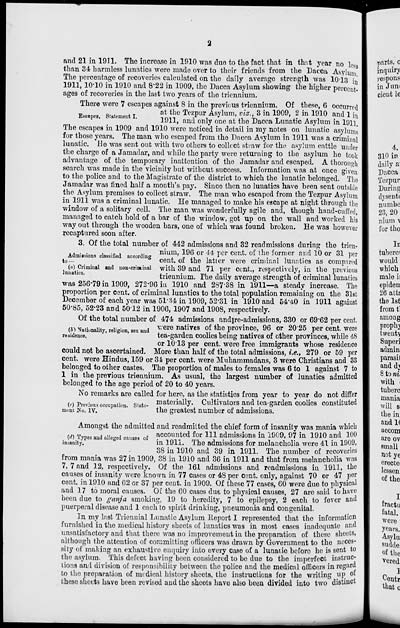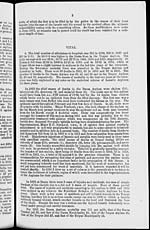Medicine - Mental health > 1903-1911 - Triennial report on the lunatic asylums in the province of Eastern Bengal and Assam > 1909, 1910, 1911 - Triennial report on the lunatic asylums in the province of Eastern Bengal and Assam for the years 1909, 1910, & 1911
(226) Page 2
Download files
Individual page:
Thumbnail gallery: Grid view | List view

2
and 21 in 1911. The increase in 1910 was due to the fact that in that year no less
than 34 harmless lunatics were made over to their friends from the Dacca Asylum.
The percentage of recoveries calculated on the daily average strength was 10.13 in
1911, 10.10 in 1910 and 8.22 in 1909, the Dacca Asylum showing the higher percent-
ages of recoveries in the last two years of the triennium.
Escapes. Statement I.
There were 7 escapes against 8 in the previous triennium. Of these, 6 occurred
at the Tezpur Asylum, viz., 3 in 1909, 2 in 1910 and 1 in
1911, and only one at the Dacca Lunatic Asylum in 1911.
The escapes in 1909 and 1910 were noticed in detail in my notes on lunatic asylums
for those years. The man who escaped from the Dacca Asylum in 1911 was a criminal
lunatic. He was sent out with two others to collect straw for the asylum cattle under
the charge of a Jamadar, and while the party were returning to the asylum he took
advantage of the temporary inattention of the Jamadar and escaped. A thorough
search was made in the vicinity but without success. Information was at once given
to the police and to the Magistrate of the district to which the lunatic belonged. The
Jamadar was fined half a month's pay. Since then no lunatics have been sent outside
the Asylum premises to collect straw. The man who escaped from the Tezpur Asylum
in 1911 was a criminal lunatic. He managed to make his escape at night through the
window of a solitary cell. The man was wonderfully agile and, though hand-cuffed,
managed to catch hold of a bar of the window, got up on the wall and worked his
way out through the wooden bars, one of which was found broken. He was however
recaptured soon after.
Admissions classified according
to —
(a) Criminal and non-criminal
lunatics.
3. Of the total number of 442 admissions and 32 readmissions during the trien-
nium, 196 or 44 per cent. of the former and 10 or 31 per
cent. of the latter were criminal lunatics as compared
with 39 and 71 per cent., respectively, in the previous
triennium. The daily average strength of criminal lunatics
was 256.79 in 1909, 272.96 in 1910 and 287.38 in 1911—a steady increase. The
proportion per cent. of criminal lunatics to the total population remaining on the 31st
December of each year was 51.34 in 1909, 52.31 in 1910 and 54.40 in 1911 against
50.85, 52.23 and 50.12 in 1906, 1907 and 1908, respectively.
(b) Nationality, religion, sex and
residence.
Of the total number of 474 admissions and re-admissions, 330 or 69.62 per cent.
were natives of the province, 96 or 20.25 per cent. were
tea-garden coolies being natives of other provinces, while 48
or 10.13 per cent. were free immigrants whose residence
could not be ascertained. More than half of the total admissions, i.e., 279 or 59 per
cent. were Hindus, 159 or 34 per cent. were Muhammadans, 3 were Christians and 33
belonged to other castes. The proportion of males to females was 6 to 1 against 7 to
1 in the previous triennium. As usual, the largest number of lunatics admitted
belonged to the age period of 20 to 40 years.
(c) Previous occupation. State-
ment No. IV.
No remarks are called for here, as the statistics from year to year do not differ
materially. Cultivators and tea-garden coolies constituted
the greatest number of admissions.
(d) Types and alleged causes of
insanity.
Amongst the admitted and readmitted the chief form of insanity was mania which
accounted for 111 admissions in 1909, 97 in 1910 and 100
in 1911. The admissions for melancholia were 41 in 1909,
38 in 1910 and 39 in 1911. The number of recoveries
from mania was 27 in 1909, 38 in 1910 and 36 in 1911 and that from melancholia was
7, 7 and 12, respectively. Of the 161 admissions and readmissions in 1911, the
causes of insanity were known in 77 cases or 48 per cent. only, against 70 or 47 per
cent. in 1910 and 62 or 37 per cent. in 1909. Of these 77 cases, 60 were due to physical
and 17 to moral causes. Of the 60 cases due to physical causes, 27 are said to have
been due to ganja smoking, 19 to heredity, 7 to epilepsy, 2 each to fever and
puerperal disease and 1 each to spirit drinking, pneumonia and congenital.
In my last Triennial Lunatic Asylum Report I represented that the information
furnished in the medical history sheets of lunatics was in most cases inadequate and
unsatisfactory and that there was no improvement in the preparation of these sheets,
although the attention of committing officers was drawn by Government to the neces-
sity of making an exhaustive enquiry into every case of a lunatic before he is sent to
the asylum. This defect having been considered to be due to the imperfect instruc-
tions and division of responsibility between the police and the medical officers in regard
to the preparation of medical history sheets, the instructions for the writing up of
these sheets have been revised and the sheets have also been divided into two distinct
Set display mode to: Large image | Zoom image | Transcription
Images and transcriptions on this page, including medium image downloads, may be used under the Creative Commons Attribution 4.0 International Licence unless otherwise stated. ![]()
| Permanent URL | https://digital.nls.uk/83166975 |
|---|



![[Page 1]](https://deriv.nls.uk/dcn4/8316/83166974.4.jpg)
